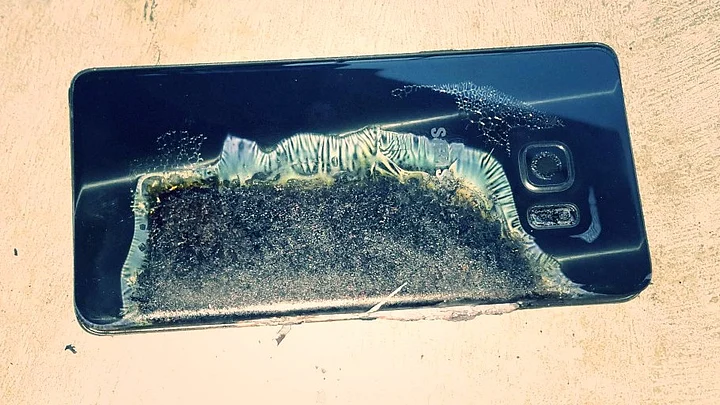The past few weeks have been extremely harsh for Samsung Electronics. The company’s flagship phone, Galaxy Note 7 – which launched hurriedly to gain an advantage over Apple’s iPhone 7 – has been reported to go up in flames due to faulty batteries. This was followed by reports of a Galaxy Note 2 device catching fire mid-air on an Indigo Airlines flight, leading to an emergency landing. And now, fresh reports have emerged of an iPhone exploding in a student’s pocket in a classroom in Philadelphia, USA. The undeniable fact is, Lithium ion battery-powered smartphones can explode and it doesn’t matter what brand they belong to. It’s science.
Airlines have issued advisories against carrying and charging the phone in India, US and UK, and the overall logistical disaster has forced Samsung to withdraw close to 2 million Note 7 handsets from the market, sending their stock value into a tizzy.
But amidst the hype and hoopla, let’s understand the basics of why phone batteries are suddenly blowing up like a Rohit Shetty film.
Lithium ion batteries are used in multiple devices beyond mobile phones, laptops, electric cars, medical and scientific research equipment. That is primarily because they are considered extremely safe, provided the lithium fail-safes are in place.
With the recent row over exploding batteries in Galaxy note 7, Samsung recalled an estimated 2 million smartphones globally.
When you charge a mobile phone, there are multiple fail-safes in place. The first being the charging adapter and the cable.
If the charger is not specific to your phone model, it can result in overheating of your battery, and can damage the battery’s protection circuit. The battery charging port, such as micro USB design, Type C, Apple’s proprietary Lightning port is also a battery fail-safe. It regulates the amount of electrical flow and protects the battery against faulty and unreliable third party chargers. And last but not the least, the battery itself also has a fail-safe called the protection circuit. This controls the flow of electricity and the temperature of the battery.
Most of the public posts that report of Samsung Galaxy Note 7 catching fire or getting burnt show no signs of burn marks near the charging port of connectors to the motherboard. The heating is concentrated to the region where the actual battery sits. This means there is no issue with the ports of the circuitry connecting the battery to the SoC (System on Chip). The issue is with the battery hole and the thick aluminium mid-frame. Why is the battery misbehaving?
Tesla Motors use lithium-ion batteries in their cars too, in fact, a huge custom stack. The unique stack of these batteries is a marquee feature of Tesla’s innovative electric supercars. But earlier Model S cars did report batteries in the undercarriage catching fire due to contact with debris on the road. Elon Musk and team fixed the issue by providing a titanium plate that protects the batteries from any road residue.
Samsung and other mobile phones face no such issues of interacting with other elements in the environment. The phone battery sits well protected amidst solid metal frames in the phone chassis.
The reason for exploding batteries could then be narrowed down to these issues. Overcharging, shorting, or impurities in the composition of the lithium-ion battery itself. Teardown videos by YouTubers and bloggers have shown that a mere contact of the lithium battery with a piece of metal results in instant combustion.
Phone batteries can also fail due to faulty circuitry that shorts the battery causing it to explode.
In some cases, the phone has exploded while charging. With electricity flowing in, the tiny regulator fails to do its job resulting in a thermal surge and the voltage regulator cannot stop the mad max turn of events.
Also remember, most phone batteries are tightly packed in the phone architecture. Most flagship phones come in unibody designs these days. And school physics explains, higher the pressure, greater is the force exerted, which is why phone batteries explode with such gusto when something goes wrong.
Making electronic devices includes hundreds of components and the end product is only as good as the raw materials put to use. While most companies eliminate the chances of such hazards by excessive quality control, an accident like this can never be completely ruled out.
Even in Samsung’s case, there have been less than 100 reported incidents out of a batch of 2 million Samsung Galaxy Note 7s.
It doesn’t take a maths genius to figure that it’s a very very low probability. And mind you, it isn’t just Samsung’s problem. Reliance Jio’ LYF phones, Xiaomi’s phones, even Apple iPhones have reported of battery burndowns and explosions.
So here’s what you can do to avoid any untoward incidents with your phone batteries.
With these simple yet effective precautionary measures, you can safeguard your precious investment, ie. your smartphone, and save yourself from feeling the burn!
- Avoid using third party non-certified chargers. It is simply not worth saving money and buying a cheap and unreliable Chinese charger for your phone.
- Avoid overcharging your phone battery. NEVER put your phone on charge and go to sleep. Instead, charge it through the day. Use certified power banks from reputed companies. If the power bank has crazy good milliamperage and costs too less, its quality could be highly suspect.
- Do not exert too much pressure on your smartphone.
(Source: Complex.com)
(At The Quint, we question everything. Play an active role in shaping our journalism by becoming a member today.)
